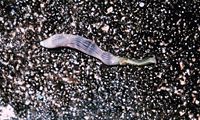Sipuncula
| Sipuncula
| ||||||||
|---|---|---|---|---|---|---|---|---|
 | ||||||||
| Scientific classification | ||||||||
| ||||||||
|
The Sipuncula or Sipunculida, sipunculid worms or peanut worms, are a phylum containing 144-320 species (estimates vary) of bilaterally symmetrical, unsegmented marine worms. Sipunculid worm jelly (土笋冻) is a delicacy in the town of Xiamen in Fujian province of China.
Habitat
Sipunculids are relatively common, and live in shallow waters, either in burrows or in discarded shells like hermit crabs do. Some bore into solid rocks to make a shelter for themselves. Although typically less than 10 cm long, some sipunculans may reach several times that length.
Anatomy
The most recognizable part of Sipunculan worms is their mouth, which is surrounded by a mass of 18 - 24 tentacles, all of which may be inverted into the body. There is no segmentation or septa present in Sipunculans. Their body consists of an introvert and a trunk, the introvert being retractable into the trunk. The digestive tract of Sipunculans passes from the mouth to the posterior end of the body, before twisting back around itself and ending at the anus, on the dorsal side of the body. The anus is often not visible when the introvert is retracted into the trunk. A few taxa possess a calcified plate called the anal shield. Sipunculans have a coelom. However, they do not have a vascular blood system. Instead, interstitial fluid transports oxygen and nutrients around the body. A separate cavity fills the hollow tentacles; it passes oxygen from the tentacles to the coelom. The body wall is strong and muscular; when threatened, Sipunculids can retract their body into a shape resembling a peanut kernel. This is where the name "Australian peanut worm" comes from.
Reproduction
Asexual and sexual reproduction can be found in Sipunculans, although asexual reproduction is uncommon. Sipunculans reproduce asexually via transverse fission followed by regeneration of vital body components. As for sexual reproduction, Sipunculans are dioecious. Their gametes are produced in the coelomic lining, where they are released into the coelom to mature. These gametes are then picked up by the metanephridia system and released into the aquatic environment. Fertilization in Sipunculans is external. Once male and female matured gametes meet, a Trochopore larva develops followed by a Pelagosphera larva to a juvenile and finally into an adult.
Relationships
The phylogenetic placement of this phylum has proved troublesome. Originally classified as annelids, despite the complete lack of segmentation, bristles and other annelid characters, the phylum Sipuncula was later allied with the Mollusca, mostly from developmental and larval characters. Nowadays, these two phyla are generally included in a larger group, the Lophotrochozoa, that also includes annelids, ribbon worms, and four other phyla.
Fossil record
The fossil record of the Sipuncula is, not surprisingly for soft-bodied animals, sparse. Some scientists, however, consider that hyoliths, operculate shells from the Palaeozoic may be related to the sipunculids, with the only remnant of the shell in extant forms being the anal plate.
Even excluding hyoliths, fossils of sipunculans are known extending back to the Cambrian Period. Fossils of the genera Archaeogolfingia and Cambrosipunculus from China are not drastically different from members of the Sipunculidea living today. [1]
ReferencesISBN links support NWE through referral fees
- ↑ Huang, D. Y., J.-Y. Chen, J. Vannier, and J. I. Saiz Salinas (2004). Early Cambrian sipunculan worms from southwest China. Proceedings of the Royal Society of London Series B 271 (1549): 1671–1676.
External links
Credits
New World Encyclopedia writers and editors rewrote and completed the Wikipedia article in accordance with New World Encyclopedia standards. This article abides by terms of the Creative Commons CC-by-sa 3.0 License (CC-by-sa), which may be used and disseminated with proper attribution. Credit is due under the terms of this license that can reference both the New World Encyclopedia contributors and the selfless volunteer contributors of the Wikimedia Foundation. To cite this article click here for a list of acceptable citing formats.The history of earlier contributions by wikipedians is accessible to researchers here:
The history of this article since it was imported to New World Encyclopedia:
Note: Some restrictions may apply to use of individual images which are separately licensed.